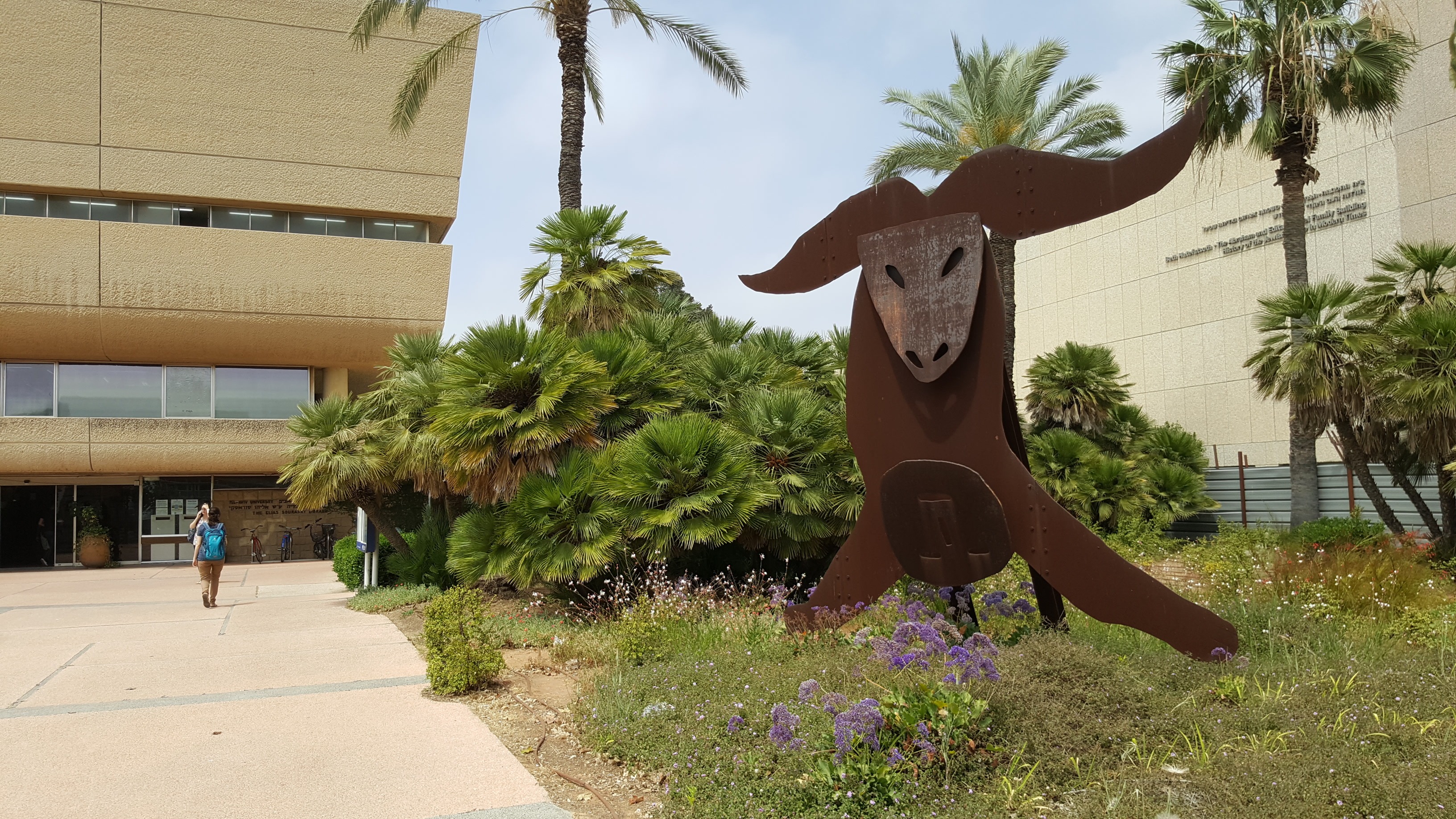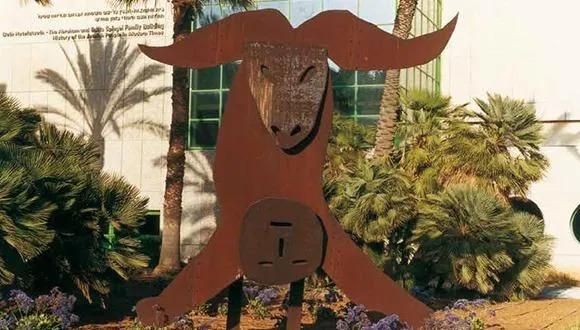Sacrifice of Isaac | Menashe Kadishman
"The story of the sacrifice is the biography I share with other members of my generation."
About the Work and the Creator / Tova Havardi
Following the Yom Kippur War, the American-Jewish sculptor George Segal arrived in Israel to work on his sculpture The Sacrifice of Isaac, for which Menashe Kadishman and his young son served as models. Towards the end of the 1970s, when his son was conscripted into the army, Kadishman himself began creating works on the theme of sacrifice. His sculpture Sacrifice of Isaac is a frontal, two-dimensional form resembling a paper cutout; it is elevated from the ground by means of two metal poles, and forms a vertically positioned oval. The upper part of this oval branches off into ram's horns, while its lower part represents the drooping arms of a child. A triangular surface affixed to the top of the sculpture stands for the ram's head, while the rounded form at its bottom stands for the child's head. The two heads are affixed to a single body, which shares the same fate. The ram's aggressive eyes and mouth are cut on a diagonal; their corners are as sharp as daggers, underscoring the animal's violent role. The child's head is overturned, as if falling, and its mouth is slightly open, as if taking its last breath.
The iconography of sacrifice throughout the history of art has been based on Genesis 22: the father is called to sacrifice his son in exchange for redemption, and the son's death is miraculously prevented. In his works on this theme, Kadishman transforms this iconographic model by doing away with the father, the angel and the miracle. In his version of this dramatic narrative the son has already been slaughtered, and the ram celebrates the triumph of evil. Kadishman challenges the morality of the biblical dictum by means of a unique connection between the Jewish myth and a modernist approach to his favorite industrial material, creating a monumental iron sculpture.
Jewish legend, the Kabbalah and Jewish philosophy all view the sacrifice of Isaac as centered upon two ideas: 1. The innocent victim's acceptance of his fate; 2. Protest against God's cruel commandment. The sacrifice is perceived as a paradigm of the Jewish victim; it suffuses the Jewish liturgy, and becomes a symbol of the annihilation of the Jews during the Holocaust. The historical narrative of the Holocaust and the foundation of the state of Israel excludes God from the story; he is replaced by the nation-state, which ordains the sacrifice of its sons. Kadishman endows the story of Isaac's sacrifice with a contemporary dimension that transforms it into a secular event, while maintaining its poignancy.

"The Altars Await the Victims"
Kadishman's break with academic sculpture, and his alternative staging of this scene, evolve out of this underlying approach, which similarly shaped the work of other Israeli artists and artists who survived the Holocaust: Marc Chagall's works communicate the message that the sacrifice is repeated with every generation, and that the sword hovers endlessly upon the son's neck as it awaits the redeeming angel. In a sketch for his painting Yellow Crucifixion (1942),2 Chagall painted a figure holding the hands of the crucified Christ; in order to relate it to the sacrifice of Isaac, this figure's head is crowned with ram's horns. A hybrid ram and human head similarly appears in Itzhak Danziger's sculpture God (1977). In his painting Sarah (1947), Mordechai Ardon introduces the mother into this scene, since she is the only one who contests God's command (according to the Midrash, Sarah was brought there by the devil). A ladder cast on the ground in Ardon's painting symbolizes the rupturing of man's relationship with God, and the secularization of the sacrifice.
In Kadishman's Sacrifice, the absence of the father attests to his responsibility. Kadishman quotes the Danish philosophy Søren Kierkegaard, who argued that the sacrifice was an act of paternal vengeance directed at the son. In this spirit, he seems to destine Isaac to death from the moment of his birth, depicting him in a fetal position. In one interview, Kadishman explained that when he first encountered Earth art, he immediately realized that he must create locally inspired art. He first turned to the theme of sacrifice when his son became a soldier. His interest in this theme was thus motivated by a personal need, and by a sense of identification with Abraham; as such, it constitutes a desperate attempt to challenge the cruelty of historical fate: "Any father who sends his son off to war is reenacting the sacrifice of Isaac. The altars await the victims. The story of the sacrifice is the biography I share with other members of my generation." The iconic models and symbols defined by earlier artists are thus transformed in his work into a highly distilled and poignant form of protest.
| Artist: | |
| Menashe Kadishman | |
| Name: | |
| Sacrifice of Isaac, 1982–85 | |
| Location: | |
| In front of the Sourasky Central Library | |
| Lent by the artist |





